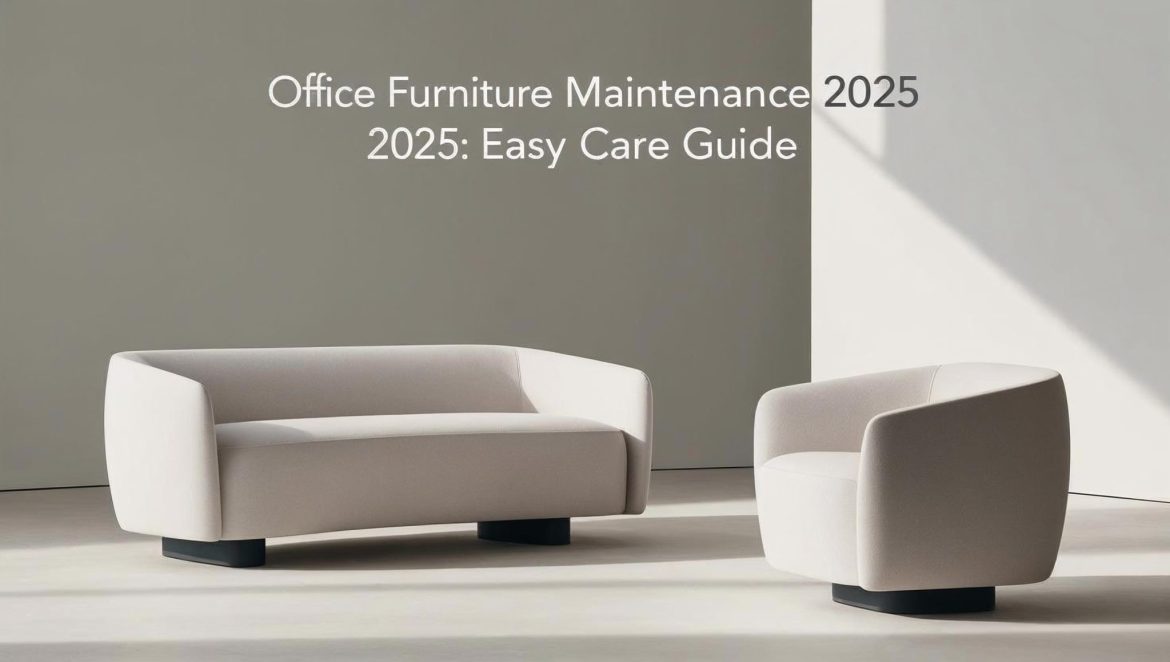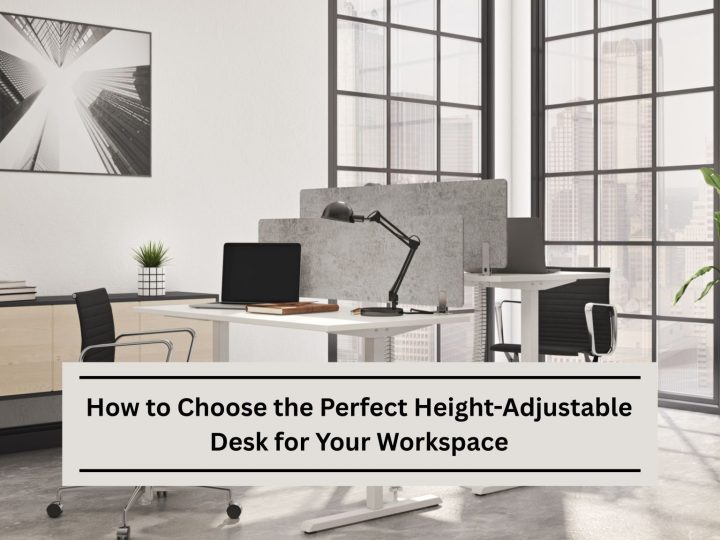

Office furniture maintenance is often overlooked, yet it plays a crucial role in workplace productivity and longevity. Studies show that employees spend between 7.7 and 10 hours daily sitting in their office chairs, making their comfort and functionality paramount. But here’s the catch: many businesses focus solely on the aesthetics of their furniture instead of its upkeep. The surprising truth is that this neglect can lead to costly repairs and replacements down the line. By adopting a proactive maintenance strategy, companies can not only save money but also enhance employee satisfaction and morale. Discover how simple steps in maintenance can have a transformative impact on your office environment.
Table of Contents
- Identifying Common Furniture Issues
- Chair Maintenance And Cleaning Tips
- Repair Techniques For Office Furniture
- Preventive Upkeep Best Practices
Quick Summary
| Takeaway | Explanation |
|---|---|
| Early Detection of Furniture Issues | Conduct regular visual inspections to identify scratches, loose joints, and mechanical problems early, preventing costly repairs and extending furniture lifespan. |
| Regular Chair Maintenance | Tighten screws monthly and lubricate moving parts quarterly to ensure optimal performance, while following specific cleaning protocols based on upholstery type to maintain appearance and comfort. |
| Structured Maintenance Schedule | Develop a comprehensive maintenance schedule that includes daily checks, weekly cleaning, and annual assessments to keep furniture in top condition and reduce replacement costs. |
| Proper Use and Staff Training | Train employees on the proper use, handling, and movement of furniture to minimize damage and promote a culture of care within the workspace. |
| Documentation for Continuous Improvement | Maintain detailed records of inspections and repairs to analyze trends in furniture issues, inform future purchasing decisions, and justify maintenance budgets. |
Identifying Common Furniture Issues

Identifying issues with your office furniture before they become major problems is a key aspect of effective maintenance. Early detection not only saves money but also extends the lifespan of your valuable workplace assets. Let’s explore how to spot common furniture problems and what signs indicate it’s time for maintenance or repair.
Visual Inspection Signs
A thorough visual inspection is your first line of defense in office furniture maintenance. When examining your furniture, look for these telltale signs of potential issues:
Wood furniture often shows wear through scratches, watermarks, or splitting edges. Check for loose joints where pieces connect—these can worsen quickly if not addressed. For metal pieces, rust spots or bent components suggest structural concerns that need immediate attention.
Upholstered items deserve special scrutiny. According to Flokk’s care and maintenance guides, fabric wear, pilling, and discoloration are common issues that can make even premium furniture look unprofessional. Check seams for unraveling threads and cushions for sagging or uneven compression.
“The fabric on office chairs typically shows the first signs of wear around the edges and in high-friction areas,” notes Ahmed, a facility manager with 15 years of experience managing corporate spaces in Dubai. “Catching these issues early can extend the upholstery life significantly.”
Mechanical and Structural Problems
Office furniture with moving parts requires special attention. Chairs with height adjustment mechanisms, swivel features, or reclining capabilities frequently develop mechanical issues. Listen for squeaking sounds when moving or adjusting furniture—this noise often indicates that lubrication is needed or that components are becoming loose.
Test every moving part during your inspection. Does your chair adjust smoothly? Do drawer slides operate without catching? Research from BTOD recommends checking for loose screws, malfunctioning height or tilt adjustments, and worn-out mechanical parts at least every six months.
For desks with adjustable heights, ensure the mechanism moves evenly without resistance. Standing desks, in particular, can develop motor issues or uneven lifting that indicates internal problems.
Floor Contact Points
The points where furniture meets the floor often develop problems first. Check chair castors for hair, debris, or carpet fibers that may impede smooth movement. Damaged castors or glides not only make furniture difficult to use but can damage your flooring as well.
For stationary furniture like cabinets and desks, inspect the leveling glides. Uneven pressure distribution can warp furniture frames over time, leading to doors that won’t close properly or drawers that stick.
Material-Specific Issues
Different materials develop unique problems:
- Leather: Look for cracking, peeling, or dry areas that indicate the material needs conditioning.
- Mesh: Check for sagging, tears, or stretched sections that compromise support.
- Laminates: Inspect for peeling edges, bubbling surfaces, or water damage.
- Glass: Examine for chips, cracks, or stress points, especially near mounting hardware.
For mesh and upholstered chairs specifically, maintenance experts point out that dust build-up, stains, and fabric deterioration are common issues that can be minimized through regular vacuuming and prompt cleaning of spills.
Documenting Your Findings
Create a simple maintenance log for your office furniture. Record when you perform inspections, what issues you find, and what actions you take. This documentation helps track recurring problems and can guide future purchasing decisions.
Many UAE businesses are now implementing digital tracking systems for their furniture assets. These systems can send automatic reminders for maintenance checks and store historical data about repairs and replacements.
By developing a systematic approach to identifying furniture issues, you create a proactive maintenance culture that preserves your investment and ensures your office remains functional and professional. Remember that early intervention with minor issues prevents costly repairs or replacements down the line—the cornerstone of effective office furniture maintenance.
Chair Maintenance and Cleaning Tips
Office chairs represent one of the most frequently used and valuable pieces of furniture in any workplace. With employees spending between 7.7-10 hours daily sitting at work according to Worksite International, proper chair maintenance isn’t just about preserving an asset—it’s about protecting employee health and productivity. Let’s explore how to keep your office chairs in optimal condition through regular maintenance and cleaning.
Regular Mechanical Maintenance
The moving parts of office chairs require consistent attention to function properly. Start by tightening all visible screws and bolts monthly—this simple step prevents the wobbling that can lead to structural damage.
Lubrication is equally important for smooth operation. Apply a silicone-based lubricant to moving parts like the tension adjustment knobs, tilt mechanisms, and height adjustment levers. Avoid oil-based products as they can attract dust and create a sticky residue over time.
“Most chair mechanisms are designed to last for years, but only with proper maintenance,” explains Tariq Mahmood, an office furniture specialist serving UAE businesses. “I recommend clients mark their calendars for quarterly maintenance checks to ensure optimal performance.”
Check the gas cylinder that controls height adjustment for signs of leaking or failure. If your chair gradually sinks while in use, the cylinder may need replacement—a common repair that costs significantly less than a new chair.
Upholstery Care
The fabric or leather covering your office chair requires specific care depending on the material:
Fabric Upholstery
Vacuum fabric seats and backs weekly using a brush attachment. This removes surface dust and prevents particles from embedding in the fibers. For deeper cleaning, most fabric chairs respond well to foam upholstery cleaners—test any product on an inconspicuous area first.
For stubborn stains, create a mild solution of warm water and dish soap. Apply it sparingly with a soft cloth, working from the outside of the stain inward. Always allow fabric to dry completely before use to prevent mildew.
Leather Upholstery
Wipe leather chairs weekly with a slightly damp microfiber cloth to remove dust. Quarterly, apply a leather conditioner to prevent cracking and maintain suppleness. Keep leather chairs away from direct sunlight, which can cause fading and drying.
Mesh Upholstery
Mesh chairs have become increasingly popular in UAE offices due to their breathability in the warm climate. Clean mesh by vacuuming with a soft brush attachment, then wiping with a cloth dampened with mild soap and water. Avoid excessive moisture which can damage the underlying frame.
Wheel and Base Maintenance
Chair wheels (castors) collect hair, dust, and debris that can impede movement and eventually damage both the wheels and your flooring. Monthly, turn the chair over and remove visible debris from the wheels.
For thorough cleaning, pop out the castors (if your chair design allows) and remove wrapped hair and accumulated dirt. Wipe them with a disinfectant solution before reinserting.
The chair base needs attention too—wipe metal bases with a damp cloth and mild cleaner. For plastic bases, use products specifically formulated for plastics to avoid degradation.
Maximizing Chair Lifespan
With proper maintenance, high-quality ergonomic office chairs should last at least 7 years according to Comfort Global, with premium chairs often carrying 10-year warranties. However, research suggests there’s currently a gap in guidelines regarding how to assess the ongoing performance of ergonomic chairs after they enter the workplace.
To ensure you’re getting the maximum lifespan from your office chairs:
- Create a maintenance schedule with clearly assigned responsibilities
- Train employees on proper chair adjustment and usage habits
- Implement a rotation system for chairs in high-use areas
- Keep spare parts for common repairs (castors, arm pads) on hand
Professional Maintenance Services
For UAE businesses managing large numbers of office chairs, professional maintenance services can be a cost-effective solution. Many furniture dealers in Dubai and Abu Dhabi offer scheduled maintenance plans that include deep cleaning, mechanical checks, and minor repairs.
These services typically document the condition of each chair, providing valuable data for planning future replacements and budgeting for ongoing maintenance.
Proper chair maintenance not only extends the life of your furniture but also ensures your team members receive the ergonomic support they need daily. By implementing these cleaning and maintenance practices, you’ll protect your investment while supporting workplace comfort and productivity.
Repair Techniques for Office Furniture
When office furniture shows signs of wear or damage, knowing how to perform basic repairs can save your business significant replacement costs. With the right techniques and tools, many common furniture issues can be resolved in-house, extending the life of your workplace assets. Let’s explore practical repair approaches for different furniture types and materials.
The Repair Process Framework
According to Carpentry A, an effective furniture repair follows a systematic process that includes inspection, diagnosis, repair, testing, and cleanup. This structured approach ensures that repairs address the root cause rather than just the symptoms of furniture damage.
Start with a thorough assessment to identify all damage points. Then diagnose the underlying issues—is a wobbly desk simply loose, or is there structural damage to the joints? Only after proper diagnosis should you proceed with repairs, followed by testing for safety and functionality before returning the item to service.
Wood Furniture Repair Techniques
Wooden desks, conference tables, and storage units frequently develop scratches, dents, and loose joints. Here’s how to address these common issues:
Surface Scratches
For light surface scratches, mix equal parts vinegar and olive oil, apply to the scratched area with a soft cloth, and buff gently. This homemade solution works particularly well on darker woods.
Deeper scratches require more intervention. Wood Rich Brand suggests a technique that works well: clean the area thoroughly, apply stainable wood filler that matches your furniture color, allow to dry, sand flush with fine-grit sandpaper (220 grit or higher), and apply an appropriate finish to match the surrounding wood.
For UAE’s businesses with premium wooden furniture, color-matched repair kits are available from specialty suppliers in Dubai’s Al Quoz industrial area and Abu Dhabi’s Mussafah district.
Loose Joints
Wobbly furniture often results from loose joints. Disassemble the joint if possible, clean old glue residue with a damp cloth, apply fresh wood glue to all contact surfaces, reassemble, and clamp until completely dry (typically 24 hours). For added strength in frequently used furniture, consider reinforcing with corner brackets installed on non-visible surfaces.
Water Damage
Water rings on wooden surfaces—common in meeting rooms where drinks are served—can be addressed by applying a paste of equal parts baking soda and toothpaste. Rub gently with the grain, then wipe clean and polish. For more stubborn water damage, light sanding followed by refinishing may be necessary.
Metal Furniture Repairs
Metal furniture components like desk frames and chair bases present different repair challenges:
Paint Chips and Scratches
For small chips in painted metal surfaces, clean thoroughly with alcohol, apply a matching touch-up paint with a fine artist’s brush, and seal with a clear protective coat after drying. When matching colors, bring a small removable part to paint suppliers for precise color matching.
Loose Connections
When metal components loosen, first check if tightening existing fasteners resolves the issue. If threads are stripped, replace the screws with slightly larger ones or use thread repair inserts. For welded joints that have failed, professional welding services are recommended as this requires specialized equipment and skills.
Upholstery Repairs
Office chairs and lounge furniture with fabric or leather upholstery require different repair approaches:
Small Tears in Fabric
For minor tears in fabric upholstery, use iron-on patches applied from the underside when possible. For visible repairs, use fabric glue and matching thread to create nearly invisible mends.
Leather Patches
Small tears in leather can be repaired using leather repair kits available from furniture suppliers. These typically include color-matched compounds that can be built up in layers to recreate the original texture and appearance.
When to DIY vs. When to Call Professionals
While many repairs can be handled in-house, some situations warrant professional intervention:
- Structural damage affecting furniture stability and safety
- Repairs to high-value executive furniture where amateur efforts might reduce value
- Specialized materials requiring specific techniques or tools
- Warranty-covered items where DIY repairs might void remaining coverage
Many furniture suppliers in the UAE offer repair services, and independent repair specialists can be found in Dubai, Abu Dhabi, and Sharjah. For businesses maintaining large furniture inventories, developing a relationship with a reliable repair service is worth considering.
Preventive Measures
The best repair is the one you never need to make. Implement these preventive practices:
- Apply protective pads under items that might scratch surfaces
- Use coasters consistently to prevent water damage
- Educate staff on proper furniture use and immediate reporting of damage
- Schedule quarterly inspection of all furniture to catch issues early
By combining these repair techniques with the maintenance practices discussed earlier, UAE businesses can significantly extend the useful life of their office furniture, managing assets more effectively while maintaining a professional workplace appearance.
Preventive Upkeep Best Practices

Preventing furniture damage is significantly more cost-effective than repairing or replacing items. A proactive approach to office furniture maintenance can extend your furniture’s lifespan by years and maintain its appearance and functionality. Here are best practices that UAE businesses can implement for effective preventive upkeep.
Creating a Maintenance Schedule
The foundation of preventive maintenance is a well-structured schedule. Develop a calendar that outlines daily, weekly, monthly, quarterly, and annual maintenance tasks. Assign clear responsibilities to specific team members or departments to ensure accountability.
Your schedule should include:
- Daily quick visual inspections
- Weekly surface cleaning
- Monthly hardware tightening and lubrication
- Quarterly deep cleaning and thorough inspections
- Annual professional assessment of all furniture assets
Digital maintenance tracking systems can automate reminders and document completion of tasks. Many UAE facility management companies now offer specialized software for this purpose, allowing businesses to maintain comprehensive maintenance histories for insurance and warranty purposes.
Proper Cleaning Protocols
Regular cleaning is fundamental to preventive maintenance. According to BTOD, upholstery maintenance should follow specific guidelines: mix a few drops of mild soap with distilled water, wipe surfaces with a lint-free rag, and follow with a clean, dry rag to prevent residue buildup.
Create material-specific cleaning protocols:
- Wood surfaces: Use cleaners specifically formulated for wood
- Metal components: Apply non-abrasive cleaners that won’t scratch finishes
- Glass elements: Use ammonia-free glass cleaners to prevent damage to surrounding materials
- Plastic components: Choose cleaners that won’t cause brittleness or discoloration
Train cleaning staff on these protocols to prevent damage from inappropriate cleaning methods or chemicals.
Environmental Controls
The UAE’s climate presents unique challenges for furniture maintenance. Implement these environmental controls to mitigate damage:
- Maintain consistent indoor humidity levels (40-60%) to prevent wood components from warping or cracking
- Use window treatments to block direct sunlight that can fade upholstery and damage wood finishes
- Position furniture away from air conditioning vents to prevent localized drying
- Install protective floor mats under rolling chairs to prevent both floor and castor damage
Usage Guidelines and Staff Training
Many furniture issues stem from improper use. Develop clear usage guidelines and conduct regular training sessions for all employees. These guidelines should cover:
- Proper seating posture and chair adjustment
- Weight limitations for various furniture pieces
- Protocols for moving furniture (lift, don’t drag)
- Reporting procedures for damaged furniture
“The most common preventable damage we see comes from improper movement of furniture,” notes Fatima Al-Mansoori, a facilities manager for a large Dubai-based corporation. “Simple training on how to lift rather than drag furniture can eliminate 30% of repair requests.”
Pre-emptive Risk Assessments
Regularly assess your workspace for conditions that might accelerate furniture wear. Professional Installers recommends conducting pre-installation safety assessments to identify potential hazards like uneven flooring and poorly positioned electrical outlets—factors that can lead to furniture damage and safety issues.
Consider these factors in your assessments:
- Traffic patterns that cause excessive wear on specific furniture pieces
- Areas with food and beverage consumption that increase spill risks
- Spaces with higher dust accumulation that require more frequent cleaning
Sustainable Maintenance Practices
As UAE businesses increasingly adopt sustainability initiatives, furniture maintenance offers opportunities to implement environmentally friendly practices. According to Habitaction, zero-waste practices including comprehensive recycling and waste-reduction programs will become defining features of sustainable office design and maintenance by 2025.
Implement these sustainable maintenance approaches:
- Use environmentally friendly cleaning products
- Repair and refurbish rather than replace when possible
- Maintain a small inventory of spare parts to extend furniture life
- Create a furniture rotation plan to distribute wear evenly
Documentation and Analysis
Maintain detailed records of all preventive maintenance activities and any issues discovered. This documentation allows you to:
- Identify recurring problems that might indicate design flaws or quality issues
- Analyze the cost-effectiveness of your maintenance program
- Make data-driven decisions about future furniture purchases
- Justify maintenance budgets based on demonstrated savings
Professional Maintenance Contracts
For businesses without dedicated facilities staff, professional maintenance contracts offer a structured approach to preventive care. Many UAE furniture suppliers offer maintenance packages that include regular visits, preventive care, and priority response for repairs.
These contracts typically cost 5-10% of the furniture’s value annually but can extend furniture life by 30-50%, making them a sound investment for high-value office setups.
By implementing these preventive upkeep best practices, UAE businesses can significantly reduce furniture replacement costs while maintaining a professional, comfortable workplace environment that supports productivity and projects a positive company image to clients and staff alike.
Frequently Asked Questions
What are the key steps in maintaining office furniture?
Regular maintenance includes conducting visual inspections, tightening screws, lubricating moving parts, and following proper cleaning protocols tailored to the materials used.
How often should I inspect my office chairs for maintenance?
It’s recommended to inspect your office chairs at least every six months, checking for mechanical issues, upholstery wear, and ensuring all moving parts function correctly.
What are common signs that office furniture needs repair?
Common signs include scratches, loose joints, squeaking noises, and upholstery wear, such as sagging or discoloration. Prompt attention to these issues can prevent further damage.
When should I consider hiring professional maintenance services for my office furniture?
You should consider hiring professional services for deep cleaning, mechanical checks, and repairs, especially for high-value furniture or if the damage affects the structural integrity and safety.
Enhance Your Office Productivity with SAGTCO Furniture Solutions
Don’t let negligence in furniture maintenance impact employee comfort and performance. As highlighted in our Office Furniture Maintenance 2025: Easy Care Guide, a proactive approach to maintaining your office furniture can lead to significant cost savings and improved workplace morale. Regular inspections, proper cleaning, and timely repairs aren’t just recommendations—they’re essentials for fostering a productive environment.

At SAGTCO, we understand the intricacies of maintaining a productive workspace. That’s why we offer modern, customizable office furniture solutions designed for durability and ease of maintenance. With our comprehensive catalog, you’ll find everything from ergonomic office chairs to sophisticated desks tailored to fit your unique needs. Enhance the aesthetics and functionality of your workplace while ensuring longevity with our expertly crafted products.
Ready to transform your office into a productive haven? Visit us at SAGTCO.com for free space planning consultations and to explore our extensive range of office solutions today!




